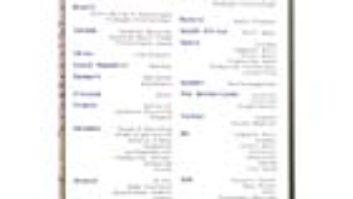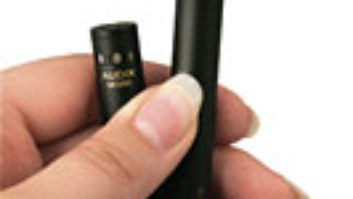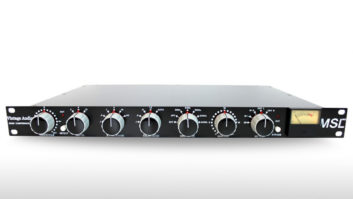
A lot of trade shows are large, but in the field of pro audio/M.I. events, Frankfurt, Germany’s Musikmesse/Pro Light+Sound (March 29 to April 1, 2006) takes the prize, with 15 exhibit halls showing the latest gear from 2,321 companies. And this year, attracting 101,200 visitors from 120 countries, there’s no question that Musikmesse/Prolight+Sound has developed into the premier international marketplace for audio, music, DJ and lighting gear. The combined event is something like attending Winter NAMM, ETS-LDI, AES, DJ Expo, NSCA and more—all squeezed into four exhausting days.
advertisement
Newcomers attending Musikmesse can easily become awestruck by the show’s sheer size. Yet even with the show’s immense scale (with nearly twice as many booths as NAMM), Musikmesse—and the Pro Light+Sound expo held next door—is surprisingly manageable to attend from a logistics standpoint, and the show’s organizers put in extra effort to make for a pleasant Messe. For example, your show badge also grants free access to Frankfurt’s excellent public transit system, and an S-Bahn (subway) station is conveniently located in the center of the fairgrounds. (“Messe” is the German word for “fair.”) Also, many of the halls are stacked above one another, so your next appointment may just be an escalator ride away. Additionally, the facility has free shuttle buses within the fairgrounds that run about every 90 seconds, taking showgoers on a route that loops between the halls, so getting from Halle #1 to Halle #9 takes no more than a few minutes. And your Musikmesse badge get you into Pro Light+Sound (and vice versa).
At this year’s show, the vibe was upbeat. Attendance increased nearly 10 percent over last year’s figures, and just about everyone said the right people were here. Although weaker than it was four years ago, the U.S. dollar was about 10-percent stronger against the Euro than a year earlier, which still puts a squeeze on European manufacturers that are trying to avoid raising retail prices in the U.S. At the same time, this exchange-rate imbalance provides U.S. companies with an economic edge in the European market. As a result, U.S.-based manufacturers—ranging from Harman, Telex, Loud Technologies, Apple, Peavey/Crest, Numark/Alesis, Digidesign, E-mu, M-Audio, MOTU, Cakewalk, ART and Meyer Sound, to smaller companies such as Event, PreSonus, Groove Tubes, Audix, Gold Line and Universal Audio—all reported brisk business. Meanwhile, when you see high-end audio exhibitors such as SSL, Neve, DPA, Neumann and Millennia Media at a Musikmesse show, you gotta figure something’s up. And if there was even an indicator of the blurring lines between pro and M.I., this was it.
The joint was packed. Attendees (mostly dealers and distributors) were spending and everybody was in a good mood. (Isn’t this what trade shows are supposed to be all about?) If you’ve never attended a European show, you should know that there’s a bar (and occasional complete lounge) built into nearly every booth. German beer is very good and Messe-style is a very civilized way of doing business. Now you know the real reason why it’s hard to make it through all of those halls in a couple days.
ON WITH THE SHOW!
Coming on the heels of NAMM and NSCA, one might assume that the gargantuan (15-exhibit hall!) convention might lose some of its attraction as a launch pad for new gear, but as in years past, we found no shortage of cool product debuts—from fun musical toys to high-end pro gear. There was plenty to see, but this time around, it was pro audio rather than musical technologies grabbing most of the headlines.

Midas XL8 Digital Console
Midas (www.midasconsoles.com) unveiled its long-awaited XL8 Live Performance System, which goes beyond the duties of a digital console, providing an open-architecture, cross-platform, integrated audio control and distribution system for handling all audio aspects of a live performance from a single control center. Midas’ emphasis was creating a high-performance, 96kHz system with the reliability of distributed pathways, redundant routers, dual stage boxes, multiple DSP engines and a separate control computer on each of its five console bays for fail-safe operation. Everything runs over a standard Ethernet physical layer, but uses a proprietary MidasNET protocol, which avoids Ethernet packeting to offer low, ideal-for-IEM latency (said to be 0.4 ms after six hops and a total A/D of less than 2 ms). The stack-for-more I/O stage boxes each include 24 remoteable mic preamps with three (recording/broadcast/monitor) analog mic splits linked to 96 channel inputs (plus 16 mic/line aux ins). Color-coded controls, 72 faders, single-function paging knobs, and high-res, daylight-view TFT screens are included for ease of use.
In fact, new digital consoles for live sound seemed to be the talk of the show. Soundcraft (www.soundcraftdigital.com) officially launched its Vi6 (previewed at mixonline.com/news/headline/soundcraft-digital-liveconsole-032306/index.html).
Shown earlier at AES New York, Allen & Heath‘s (www.allen-heath.com) iLive and EAW‘s (www.eaw.com) UMX.96 made their European debuts. Digital console pioneers InnovaSon (www.innovason.com) celebrated the 10-year anniversary of Sensory, its first digital live board, and showed its new EtherSound-enabled Dio Core stage boxes for its current Sy40, Sy48 and Sy80 mixers.
LOUD, LOUD, LOUDSEAKERS
Just two weeks after the NSCA systems contractors show in Las Vegas, one might not expect to see a lot of new touring speakers, but this show had plenty.
Nexo‘s (www.nexo-sa.com) GEO D three-way vertical array features two 8-inch side-firing mids, a front-facing single 12-inch and a 3-inch voice coil HF compression driver on the company’s Hyperboloid Reflective Wavesource. The 55-pound, 14x29x30-inch cabinet is used with at least four boxes per side, and its Geobumper rigging allows flying up to 24 GEO Ds. Nexo’s cardioid GEO Subs for extended LF are available, as is a stage stack option.
Turbosound (www.turbosound.com) expanded its Aspect Series with the TA-500, a three-way trapezoidal box with a 15-inch LF, 10-inch cone mid and HF compression driver on Polyhorns, so it’s voiced like the longer-throw Aspect TA-880 boxes but designed for wide-dispersion applications such as regional tours and theaters.
Alcons Audio‘s (www.alconsaudio.com) SR9 is an ultra-compact ribbon tweeter speaker designed for high-fidelity, wide-splay use, such as frontfill or under-balcony.
Electro-Voice (www.electrovoice.com) reintroduces its popular Manifold Technology with the Phoenix Series, updated with dual 2-inch ND2 neodymium drivers (with rotatable horns) on all of its top and monitor cabinets and the company’s new DXV woofers on the bottom end. Several companion subs are offered.
EUROMICS!
A highlight of any European show is looking for new microphones.

Neumann TLM 49
Neumann (www.neumannusa.com) has already begun initial deliveries-full production starts this month-of its TLM 49 large-diaphragm cardioid studio mic. The TLM 49 combines the famous TK47 capsule from its M49 and U47 models with transformerless, low-noise electronics, but has a response rise between 2k and 3 kHz for a warm, vintage vocal sound; the capsule is surrounded by a large, acoustically open head grille. Retail is $1,699.99, including shock-mount.
Coming later this year is Microtech Gefell‘s (www.microtechgefell.de) UM 930, a large-diaphragm, dual-capsule studio condenser with five switchable polar patterns and low 7dBa noise performance.
New from Belgian mic maker Aevox Audio (www.aevox.be) was a line of miniature mics, including lavaliers, an M Series of omnis for classical recording and the In-Ear Microphone. Built to look like earbuds, the latter fit in each ear, making your head into a binaural mic-ideal for stealth recordings for documentaries or sound effects gathering.
Along a different line was the Alva (dist. by Synthax, www.synthax.com) Micorder, which packs a solid-state recorder into a mic body, with built-in level meter, tape-transport-style controls, headphone out, MPEG or linear 48kHz PCM recording, and up to 2GB storage on removable SD cards.

Genelec 8240A DSP
MONITOR WORLD
Genelec (www.genelec.com) turned heads-and ears-with its new bi-amplified 8200 Series monitors and 7200 Series subs. Both are based on its acclaimed 8000 and 7000 speakers, but incorporate DSP and network control so systems can be quickly set up, measured, analyzed and calibrated. All accept AES/EBU digital (32 to 192 kHz) or analog signals, and include a measurement mic, Genelec Loudspeaker Management and AutoCal (PC/Mac) software. These connect via standard Cat-5 cabling to emulate the rear panel DIP switches, add shelving and notch filtering for adjusting to the room response, and provide remote-control capability for volume, solo and mute functions from a computer, USB device or custom console.
Based on its $49,000/pair ADM Zero monitors, KS Digital‘s (www.ksdigital.de) Line-Master is a column array designed for far-field mastering/critical-listening applications. Line-Masters feature FIRTEC digital room EQ, digital and analog inputs, 650W tri-amping and a slot waveguide for smooth HF performance.
ADAM (www.adam-audio.com) monitors have earned their share of fans during the years with the A.R.T. folded-ribbon tweeter technology and precise imaging. Now, ADAM offers the A7, a 100W bi-amplified system that pairs the same tweeter with a 6.5-inch woofer for a low $999/pair. An optional 160W Sub8 subwoofer with wireless remote control is $699.
SIGNAL PROCESSING
In past shows, the emphasis was on software plug-ins. This time, hardware was king.

Focusrite Liquid Mix
Focusrite‘s (www.focusrite.com) Liquid Mix takes the concept of its Liquid Channel preamp emulations and hosts 32 channels of classic EQs and vintage compressors-all available simultaneously to your DAW, appearing as a separate VST/Audio Units/RTAS effect, working within all major apps, including Pro Tools. Control is via an onscreen GUI or from the desktop unit, which houses all the DSP (no CPU strain) and connects via FireWire. Shipments begin this quarter.
Speaking of onboard DSP, TC Electronic‘s (www.tcelectronic.com) Konnekt 24D is a 14×14 (in/out) FireWire recording interface with stereo mic and DI inputs, built-in Fabrik C channel strip and Fabrik R reverb (adapted from the company’s PowerCore), and low-latency drivers for Mac OS X, Intel-based Macs, Windows XP and all apps supporting WDM, ASIO and Core Audio drivers. The DSP can be accessed while tracking, mixing or stand-alone (without computer).
A new face at Musikmesse, SSL (www.solid-state-logic.com) not only launched its second-generation AWS 900+ console/controller, but also demoed Duende, which puts part of the DSP power of its Series digital mixers into a single-rackspace box. Connecting to your DAW (Mac now, PC later this year) via FireWire, it offers up to 32 channels of SSL EQ and dynamics processing at up to 96 kHz while leaving host CPU resources free to run native plug-ins.
Another Messe newcomer, Neve (www.ams-neve.com) showed the 8803 dual-channel rackmount EQ/filters, with circuits based on Neve’s classic 8108 design, but with expanded frequency and Q ranges. Settings can be tweaked and stored from the front panel or via a Mac/PC utility. Neve also showed the 8804, which adds 16 long-throw faders for controlling its 8816 summing mixer.

Elysia Alpha Compressor
Formerly with SPL, Elysia (www.elysia.com) co-founder Ruben Tilgner created products such as Transient Designer and MixDream. Based on all-discrete Class-A topology, Elysia’s debut is the Alpha Compressor, a high-end box that features parallel compression with “wet/dry” control, soft-clip limiting, integral M/S matrixing and more.

SPL Passeq Equalizer
SPL (www.spl-usa.com) showed Passeq, a monster stereo EQ that combines three different passive EQ designs in one unit. Each channel features Lundahl I/O transformers and 72 passive filters (36 boost/36 cut per channel), followed by a gain makeup stage with SPL’s Supra op amps running on 120-volt rails providing +34 dB of headroom and a 116dB S/N ratio, for a stunning 150dB dynamic range. Retail is $4,890 USD. Less monumental perhaps are SPL’s Volume2 and Volume8 analog stereo and surround monitor volume controllers, providing a low-cost/high-quality solution to the age-old “my DAW doesn’t have a volume knob” dilemma and adds mute switching.
More complex is Centro, Audient‘s (www.audient.co.uk) stand-alone master section for the DAW studio, with rackmount I/O and a desktop remote. Centro offers monitoring from six stereo digital/four analog sources, routing of two performer cue mixes, and built-in talkback control of three speaker pairs and a sub. Shipments begin this summer.

Moog Little Phatty
AND THE REST…
We couldn’t cover a music show without selecting a fave music toy. Our choice? Moog Music‘s (www.moogmusic.com) Little Phatty, a 37-note monophonic synth with a sound engine designed by the late, great Bob Moog. Zero-latency RAC(tm) (Real Analog Control) links the front panel knobs directly with the analog circuitry. Other features include ultra-stable VCF and VCOs, 100 user-editable presets, onboard pre/post-filter distortion and ±2-octave keyboard transposing. Oh, it sounded great and was a blast to play. Retail is $1,475.
CERTIFIED HITS
Trying to pick a Top-10 coolest list from tens of thousands of products 2,500 exhibitors is no picnic. With that admittedly impossible task in mind, here our here are our coolest picks from the show, listed alphabetically…
ADAM Audio A7
Elysia Alpha Compressor
Focusrite Liquid Mix
Genelec DSP Series
Midas XL8
Moog Little Phatty
Neumann TLM 49
SPL Passeq
SSL Duende
TC Electronic Konnekt 24D
MORE TO COME!
This year, Mix, Electronic Musician and Remix joined the editors of 55 other music and audio magazines to vote for the best products of 2005/2006 at the 7th Annual Musikmesse International Press Awards (MIPA). Chosen from three finalists in each of 40 categories, the winners were announced at an awards ceremony held March 30, 2006, during this year’s Musikmesse/Pro Light+Sound show in Frankfurt, Germany.
One highlight of this year’s MIPA ceremony was the presentation of the MIPA Lifetime Achievement Award to Prof. Dr. Fritz Sennheiser, who founded Sennheiser in 1945. For a full report on the 2006 MIPA Awards (including a list of all the winners), go to mixonline.com/news/headline/2006-mipa-awards-040606/index.html.
Musikmesse/PL+S returns to Frankfurt next year from March 27-31, 2007. Meanwhile, Music China–the international trade fair for musical instruments & accessories—comes to Shanghai’s New International Expo Centre, October 18 to 21 2006. See you there!
For more information about Musikmesse, visit musik.messefrankfurt.com/frankfurt/en/home.html.






